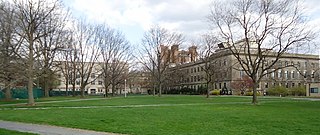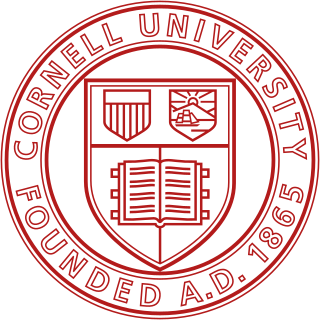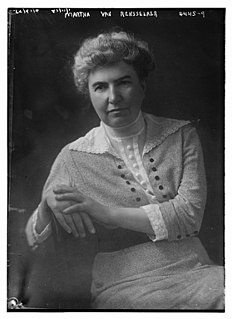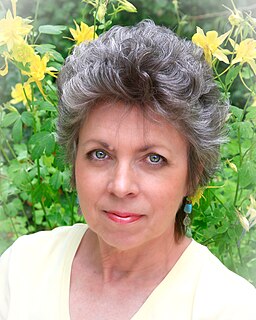
Home economics, or family and consumer sciences, is a subject concerning human development, personal and family finance, housing and interior design, food science and preparation, nutrition and wellness, textiles and apparel, and consumer issues.

The Cornell College of Agriculture and Life Sciences is a statutory college on the Cornell University campus in Ithaca, New York. With enrollment of approximately 3,100 undergraduate and 1,000 graduate students, CALS is the third-largest college of its kind in the United States and the second-largest undergraduate college on the Cornell campus.

Anna Botsford Comstock was an acclaimed author, illustrator, and educator of natural studies. The first female professor at Cornell University, her over 900-page work, The Handbook of Nature Study (1911), is now in its 24th edition. Comstock was an American artist and wood engraver known for illustrating entomological text books with her her husband, John Henry Comstock including their first joint effort, The Manual for the Study of Insects (1885). Comstock worked with Liberty Hyde Bailey, John Walton Spencer, Alice McCloskey, Julia Rogers, and Ada Georgia as part of the department of Nature Study at Cornell University. Together they wrote nature study curricula to develop a curiosity for, and education about, the surrounding natural world. Comstock also was a proponent for conservationism by instilling a love and appreciation of the natural world around us.

The Cornell University Library is the library system of Cornell University. As of 2014, it holds over 8 million printed volumes and over a million ebooks. More than 90 percent of its current 120,000 periodical titles are available online. It has 8.5 million microfilms and microfiches, more than 71,000 cubic feet (2,000 m3) of manuscripts, and close to 500,000 other materials, including motion pictures, DVDs, sound recordings, and computer files in its collections, in addition to extensive digital resources and the University Archives. It is the sixteenth largest library in North America, ranked by number of volumes held.
The Samuel Curtis Johnson Graduate School of Management is the graduate business school in the SC Johnson College of Business at Cornell University, a private Ivy League university located in Ithaca, New York. It was founded in 1946 and renamed in 1984 after Samuel Curtis Johnson, founder of S.C. Johnson & Son, following his family's $20 million endowment gift to the school in his honor—at the time, the largest gift to any business school in the world.

The School of Hotel Administration at Cornell University is a specialized business school in the SC Johnson College of Business at Cornell University, a private Ivy League university located in Ithaca, New York. Founded in 1922, it was the world's first four-year intercollegiate school devoted to hospitality management.
Urie Bronfenbrenner was a Russian-born American psychologist who is most known for his ecological systems theory. His work with the United States government helped in the formation of the Head Start program in 1965. Bronfenbrenner's ability research was key in changing the perspective of developmental psychology by calling attention to the large number of environmental and societal influences on child development.

The history of Cornell University begins when its two founders, Andrew Dickson White of Syracuse and Ezra Cornell of Ithaca, met in the New York State Senate in January 1864. Together, they established Cornell University in Ithaca, New York, in 1865. The university was initially funded by Ezra Cornell's $400,000 endowment and by New York's 989,920-acre (4,006.1 km2) allotment of the Morrill Land Grant Act of 1862

Cornell University is a private Ivy League and statutory land-grant research university, based in Ithaca, New York. Founded in 1865 by Ezra Cornell and Andrew Dickson White, Cornell was founded with the intention to teach and make contributions in all fields of knowledge — from the classics to the sciences, and from the theoretical to the applied. These ideals, unconventional for the time, are captured in Cornell's founding principle, a popular 1868 quotation from founder Ezra Cornell: "I would found an institution where any person can find instruction in any study."
The Core Historical Literature of Agriculture (CHLA) is the name of both a digital preservation project and the resulting digital library which began at Cornell University's Albert R. Mann Library in 1994. It is notable as an early digital library and, unlike later book digitization projects by Google and Microsoft, where the focus is mainly on the wholesale scanning of massive numbers of titles, its collection follows a scholarly selection methodology with a specific subject focus. Although CHLA is a much smaller collection than that of Google Books Library Project, for example, all of its titles are considered academically and historically important, and all texts in CHLA are freely accessible.
Faye Duchin is an American Computer Scientist and Professor of Economics at Rensselaer Polytechnic Institute ("RPI"), where she was the Dean of the School of Humanities and Social Sciences from 1996 to 2002. She is active in the fields of ecological economics and industrial ecology and employs Input-Output Analysis in her work. Her faculty page at RPI states that she is "concerned with ways of achieving economic development while avoiding environmental disasters."

Central Campus is the primary academic and administrative section of Cornell University's Ithaca, New York campus. It is bounded by Libe Slope on the west, Fall Creek on the north, and Cascadilla Creek on the South.
The year 2011 in architecture involved some significant architectural events and new buildings.

Lisa Staiano-Coico, or Lisa S. Coico is an American politician and academic. Coico was the twelfth president of City College of New York, from August 2010 until October 2016.

Martha Van Rensselaer was a founding co-director of the College of Home Economics, which led to the establishment of the New York State College of Human Ecology in Ithaca, New York. Van Rensselaer served as an educator and proponent of the application of knowledge to improved quality of life in the home. She called the field of study “domestic science” and focused on key aspects of homemaking.

Susan Margaret Watkins is a Cornell University professor emerita who founded the academic field of functional apparel design. She is the author of the seminal textbook in the field, Clothing: The Portable Environment (1984), and holds patents as a result of her collaborative research with the U.S. Army, the U.S. Air Force, firefighters associations, and other industrial partners. In 1991 Watkins was inducted as a Fellow into the International Textile and Apparel Association (ITAA), the highest honor awarded by the organization, for her contributions in shaping the field of functional apparel design.

Flora Rose was an American scientist, nutritionist, and co-director of what would become New York State College of Human Ecology. Rose, along with Martha Van Rensselaer, was named the first full-time female professor at Cornell University.

Alice Blinn was an American educator, home efficiency expert, and magazine editor. Born in Candor, New York, she attended the New York State normal school and became a teacher. After teaching briefly, in 1913, she entered Cornell University and earned a degree in Domestic Science. While in school, she founded and managed the Cornell Women's Review. After graduation in 1917, she became a food conservation demonstrator for the New York Extension Service and then returned after a year to teach and manage the publications office for the Extension Service at Cornell.
















